How to Regrow Vegetable Scraps
Tips for turning kitchen compost scraps into pretty spring greens.
Even thought my daughter is just six years old, it’s clear that I’m raising a little environmentalist.
Clara carries a bag and picks up garbage on our forest walks, aghast at people who litter. Of her own free will, she turns off the water in the shower when soaping and is keenly aware of water conservation. She wants to know about everything from global warming to water pollution and is fiercely protective of nature.
This simple kitchen project started as a way to demonstrate to Clara how not all vegetable scraps need to end up the compost bin – many can sprout again if given the chance. You all know how I love a good lesson from the kitchen, especially if it promotes food sustainability.
Once you start looking, there are a thousand little ways we can make environmentally friendly choices in the zero waste kitchen. Regrowing vegetable scraps is just one of them.
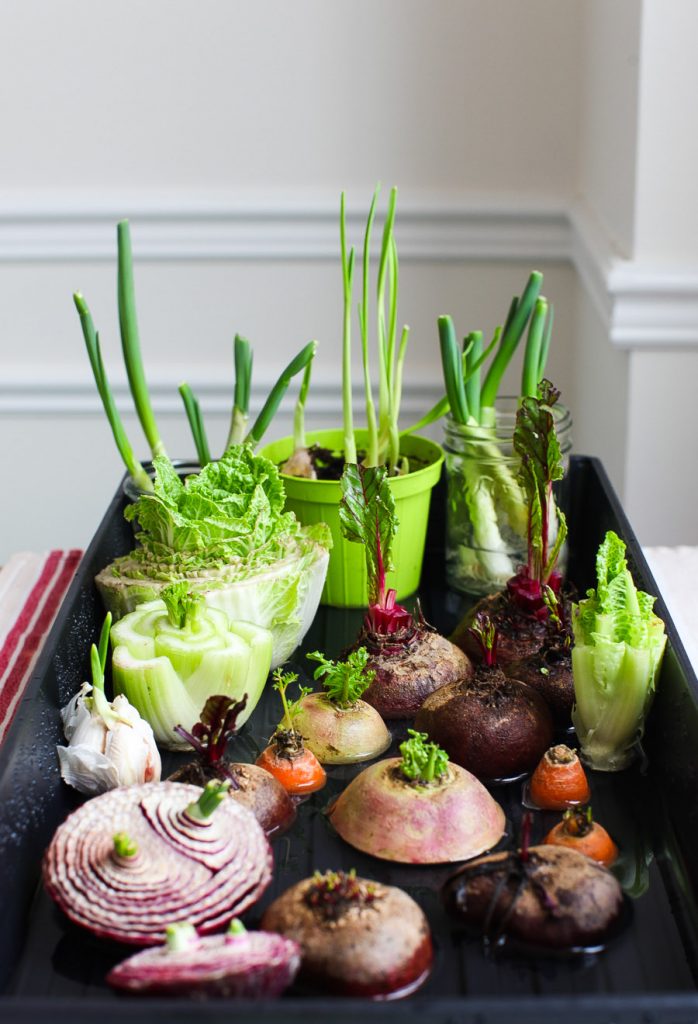
As a kid, I can remember watching celery magically regrow and carrot tops send up tall green fronds when placed in water. It’s fascinating to see what still holds life from the produce drawer, even when it’s cut down to a mere stump.
A few weeks ago I snapped the iPhone photo above and shared it on Instagram, thinking that my followers would enjoy the inspiration for a little greenery in February.
My readers responded enthusiastically and had so many questions that I decided to follow up the photo with this post. Now these tips can live on here and you can reference it as needed, because I hope you will all start regrowing your veggies.
Not only is this a fun science experiment, but I’ve been cooking these little shoots as they sprout. Green onion, Napa cabbage, onion and green garlic are all delicious in a stir-fry or fried rice. Baby beet greens, celery shoots and romaine lettuce is harvested for salads, and carrot tops can be made into pesto.
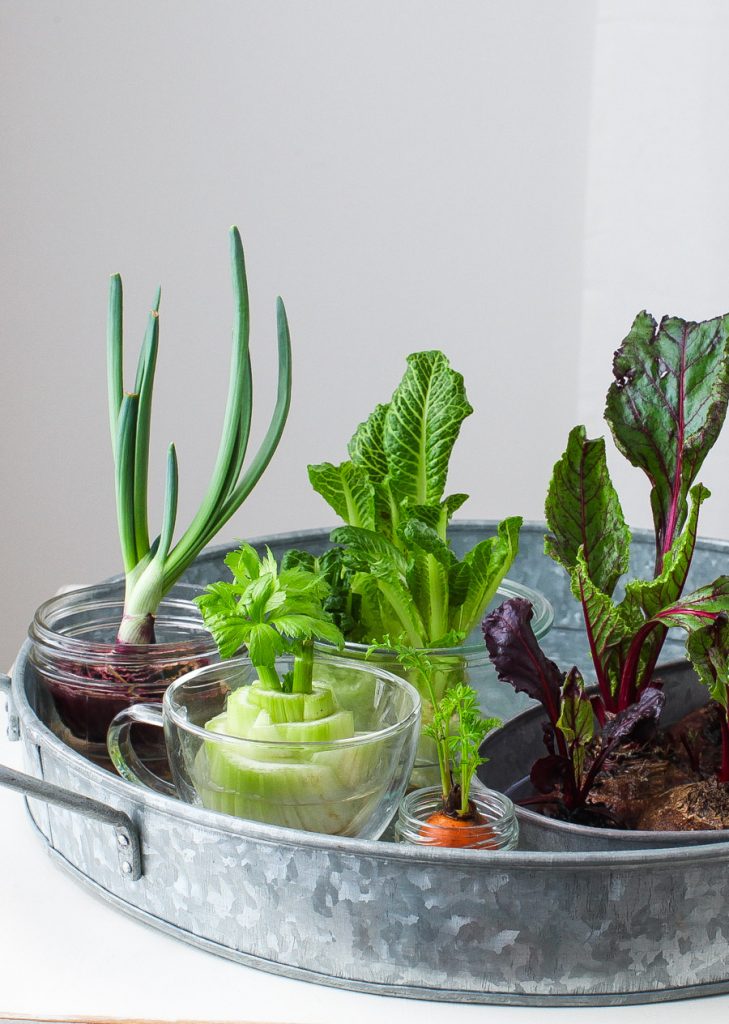
How to Regrow Vegetable Scraps: Myths Debunked
For starters, please note that this windowsill kitchen garden is not *really* to supplement your diet. Sure, you’ll be able to nibble away at your greens, but we’re not producing tons of vegetables here. I’ve seen a few articles on vegetable regrowth that claims it ‘builds self-sufficiency’. Ahem. Regrowing enough vegetables to support your diet would take a lot of space and time. And, well, a garden.
For me the goals here are part kid’s science project, part zero waste initiative, and part edible kitchen mini garden. And it’s lovely to have a bit of greenery around in the middle of winter, especially when there’s a snowstorm outside.
This also needs to be said: we are not regrowing root vegetables. When beets, carrots , turnips, etc are placed in water, they send up green shoots and it is these leafy tops that we are enjoying.
However, it is possible to completely regrow some whole vegetables. Celery, for example, if tended to properly, will regrow into full stalks. Boc choy, Romaine lettuce, green onions, fennel and leeks will all (eventually) regrow to be full sized, as well.
How to Regrow Vegetable Scraps
Starting your windowsill garden is as easy as placing the ends or tops of a few kitchen produce scraps in about an inch of fresh water and setting them in partial sunshine. Your only maintenance is to change the water daily – now you see why this is such a good project for kids.
For an easy start with quick results, begin with green onion and garlic. Place about 3 inches of the white part of green onion – with the roots attached – in a jar and in a few days, you’ll start to see regrowth. For garlic, choose a whole bulb or individual cloves that have started to send out green sprouts – we tend to see this a lot in the winter months as the garlic gets older.
A few things I’ve learned along the way:
- Keep the regrowing vegetable away from a direct heat source or they will just bake instead of grow.
- Not everything will sprout. If you’ve waited a week and seen no sign of life, try again.
- The taste on the regrown vegetables will be milder than from fresh vegetables.
- Slimy bottoms are normal.
Which scraps to regrow
If you’re wondering which end of the vegetables to keep and place in water and which to toss in the compost, here’s a quick cheatsheet.
Grow these tops:
- Carrots
- Beets
- Turnip
- Radishes
- Daikon
Cut off about 1-inch of top and place in water but do not submerge.
Grow these roots/ends:
- Green onion
- Garlic
- Fennel
- Celery
- Romaine lettuce
- Bok Choy
- Leeks
- Onions
- Lemongrass
Cut off about 1 -3 inches of bottom and place in water but do not submerge.
A few of these, like fennel and celery, may be transplanted to a garden once springtime arrives, but I feel like that is a whole new post. There’s certainly lots of information on the web around this topic, so seek it out for yourselves. Happy growing!
You may also love:
Regrow Vegetable Scraps for a DIY Spring Centrepiece
How to Move Towards a Zero-Waste Kitchen
Have you ever regrown vegetable scraps? Share your experience in the comments.

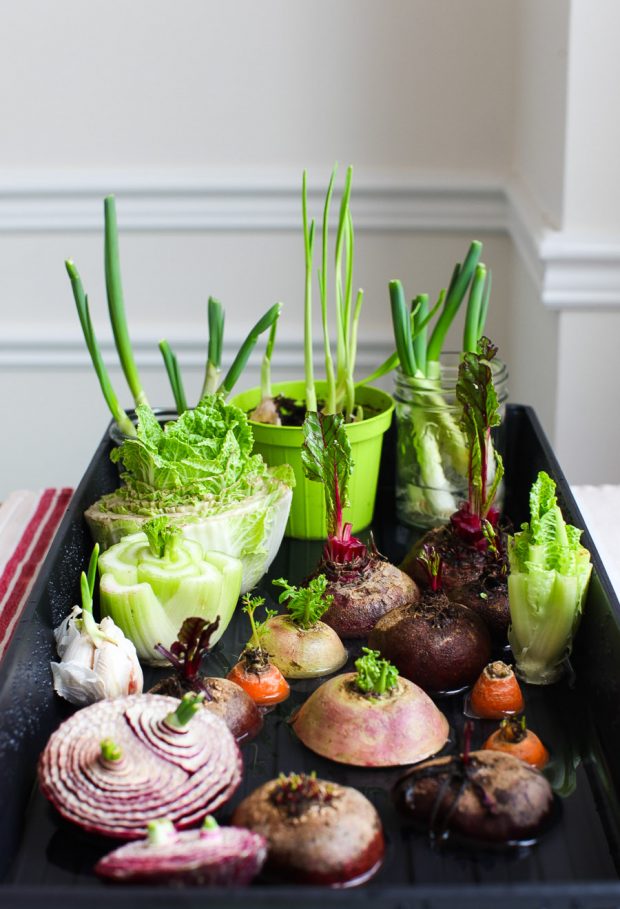
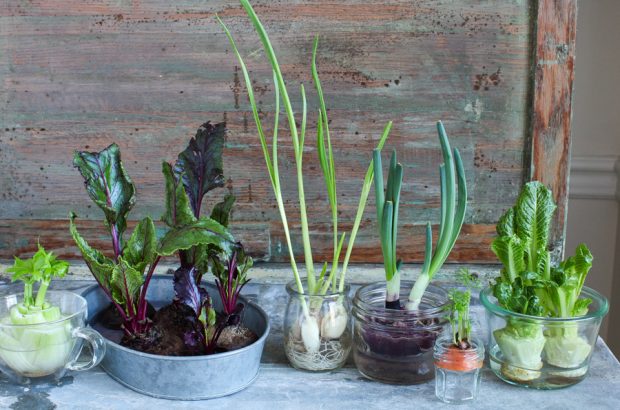
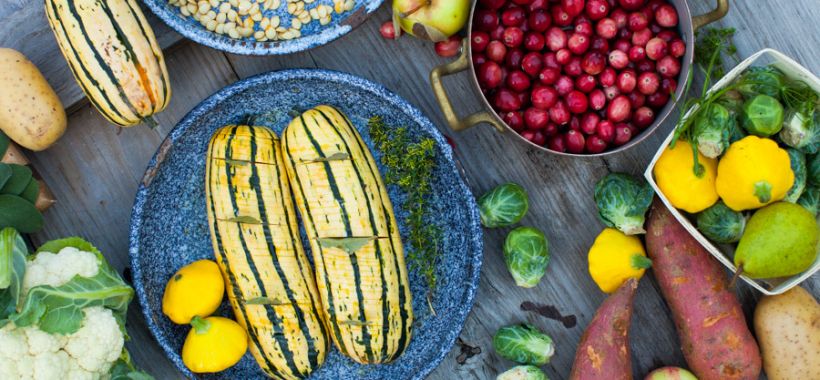

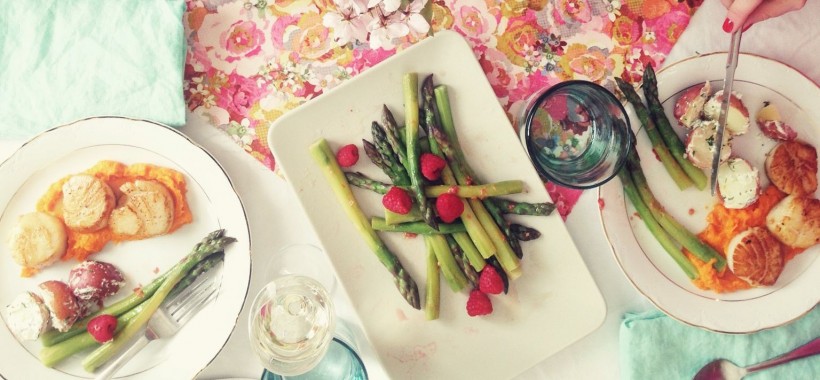
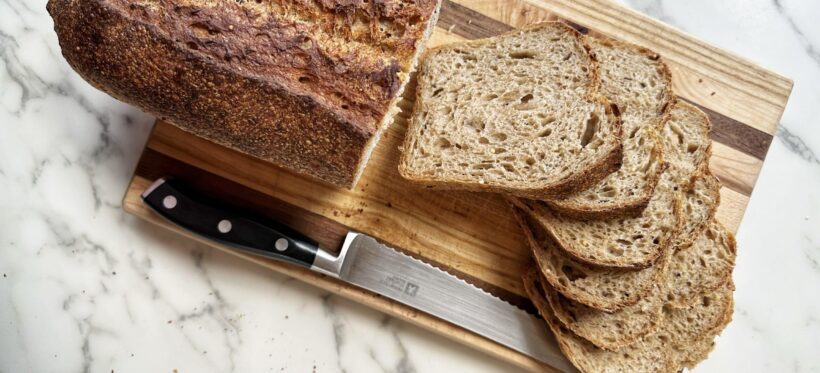
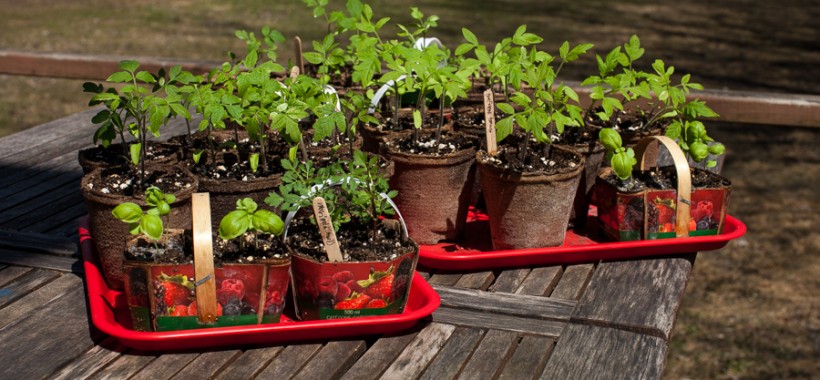
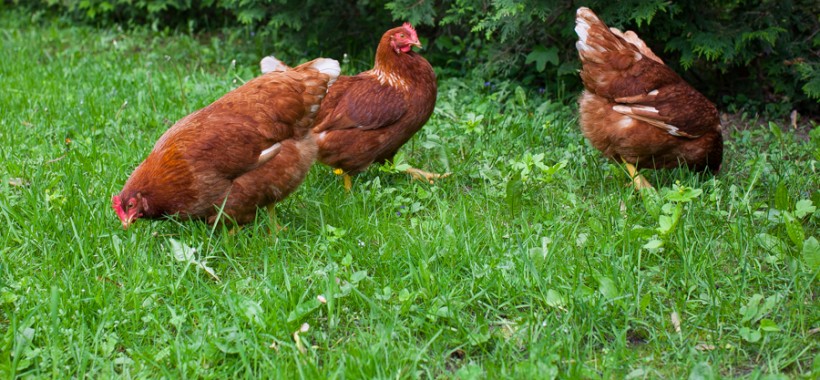
Speaking of sustainability, I would love a post about your freezer containers. I know you use Weck for some things but what about casseroles, meatball batches, etc? Do you use single-use trays or big ziplocs? If not, how do you keep them airtight? Just curious because the potential waste sometimes keeps me from doing a lot of make-ahead. I’m looking for some freezer-to-table dishes that I could purchase a number of without breaking the bank. Also, I am dying to hear your new garden plans for Halifax. Have you changed zones? What will be different? Can’t wait to read!
Oh that’s a great question! I do all sorts of things such as Pyrex with lids (freezer-to-table) and Tupperware. Meatballs I freeze in the sauce, usually in reusable containers. And I use a lot of widemouth jars for soups and stocks. I have a lot of room for improvement, but i recently read the following quote and was reminded that every little bit helps: ‘We don’t need a handful of people doing zero waste perfectly. we need millions of people doing it imperfectly.”
No garden plans until the property thaws out and I see what comes up out of the ground!
Loved your post. I could not stop but add a note once I read your comment about using Pyrex and tupperware to store your food. While I see you doing what is great for the earth, I think you should put as much care into what is great for your body. Please take a moment to read this ladies websites regarding the surprising findings of lead, arsenic, and other toxins in those containers you use. Once you do, I guarantee you will never want to use Tupperware or decorated Pyrex again.
See link below. This is the lead safe mama site.
https://tamararubin.com/?s=Tupperware
I have lived in the country for 45 years, and I know well the joy of milking my own goats and making my own cheese; I just bless you with opening many eyes to the great life that growing your own food offers, and which I have fully lived for the lst 45 years.
Green onions I knew about but the beet greens and celery were new to me. Neat! I confess that when I grow beets in the garden, it is mainly for the greens so I’m excited to see this. Beet greens in the supermarket just look so defeated most of the time.
Sue, there’s something wonderful about baby beet greens – especially in February!
I heard they are very healthy. My sister fried the in olive oil. She said they were good.
Lightly fried with Garlic, beet greens are the greatest background for Merguez and other sausages…
I’ve been happily composting for over a year and am so excited to try regrowing now! Thank your for the clear instructions.
how interesting and even really productive! Never would have imagined re-growing vegetables but for this article, thank you!
Thanks for reading, Sabrina.
GREAT POST. I enjoy growing celery plants out of the celery base, when it gets to about 3 inches tall and has a lot of roots in the water it is ready to transplant into the garden or a deep pot. Also one year I put a cabbage core (the white part) into water to root, just to try it. When it had lots of roots I planted into garden and ended up with 6 fist sized cabbages off of the one stock, that were so delicious–crazy but love how plants can be recycled.
That’s amazing, Ann!!
I love cabbage and never thought of regrowing it. Thanks
I live in Australia and have been doing this for years. I inherited a New Zealand bird from my dauhter and she had him cooped up in a tiny cage. She said he liked bits of fruit and a certain small parrot seed that had fruit and nuts in it. I put him in a larger patio aviary and bought him a companion. I did some research and found they live in forests and eat the seeds and sprouts of grasses, vegetation and fruits on the floor. I also keep cooks and have raised Budgies in the past so took some clues from that. I was giving the chickens beetroot, leaves spinach leaves, cartot tops etc. as well as grains to get beautiful fresh eggs. The leaves where often too large for the Kakariki parrots but they loved the new growth in the centre so I would save carrot and beet tops to grow greens and I grow sprouted seeds for them, especialy when breeding. I don’t have a big garden so can only buy organic produce from the market and in the summer months with temperatures around and above 100°F they dont last long out side on the market stalls. We don’t have snow but do get frosts so I grow baby spinach and rocket in pots that can be moved depending on the weather. I am growing leaves from ends in the kitchen now in March, when temperatures are still a little warm and the season is summer turning to Autum or Fall as you call it. We still have the ducted evaporative air conditioner cranked up to keep us and the birds, who live under shelter on our back verandah next to an open window, cool.
Hello Dianna, thanks for your comment. Well, WHO KNEW??
You can also regrow pineapple. I currently have an enormous pineapple plant that started from just the top of a store-bought pineapple. We have got two mini pineapples off of it. Very yummy. And it’s really pretty.
I’ve always wanted to try that, Elisa!
I have a kitchen window full of regrowth. Going to try the beets next. I tried planting my celery after getting some good roots, but honestly it was not successful. I love having everything sprouting in the window. Right now I have a pineapple in a jar with LOTS of roots, need to plant soon, my sweet potato is sprouting alone with celery and carrots…so much fun. I live in Florida, gets really hot in the summer, so this is perfect until it cools off for the garden time…enjoy your post.
I have just started some romaine. It’s amazing to see it grow in just a couple days. I was wondering how tall to let it grow. I read this article and see that snipping the new growth can be delicious and quick reward! Thank you for the article and the inspiration to have some new life mid winter!!
Thanks for reading, Sherry!
At what point do you plant the soil after they have started sprouting?
Hi Day, So this is not really the goal. Most of these will NOT regrow in soil. We are sprouting them for the greens…
However a few may be moved to soil in pots such as the celery, green onion and fennel. You can move it to soil as soon as there are a few small roots.
I started regrowing vegetable scraps a couple weeks ago during the Covid-19 quarantine. It had been a curiosity I have been covering for years and there was no better time than now. Plus, I live alone and don’t eat much, so besides providing some sustenance, they will keep me company during this lonely stay at home period lol. I used carrots, spring onions, little gems, romaine, beets, watermelon radishes. To my delight they sprouted nicely and now I have planted in soil. Too soon? Next up will be fennel and celery.
Let us know you they all turn out!
This is wonderful. And not just for your 6 year old! Thanks!
So, I also tried it and I reaaly admired the power of nature!
Thanks!
Hi Aimee,
What vegetables can I start to grow in the house and transplant to soil outside?? I’
I am so amazed by all of this planting veggies in water. I have done sweet potatoes and avocado seeds but never knew about all of the others. I just can’t wait to get started. I have a frig full of items I was going to throw out this morning. I’m so, so glad now that I have an alternative. Thank you so much for educating us. And who says you can’t teach an old dog new tricks! I plan to call my sister-in-law today to tell her about it also. We were just talking about vegetables yesterday. An added bonus is finding this at just the right time. I am still staying in because of the corona virus. So a huge “Thank You” again.
Dear Aimee, I work for Northumberland Libraries and I put together activity sheets for our young readers that we give out free of charge. I wonder if I could use your kitchen scrap activity in our May sheets please? I would credit you of course and put your website address on the page. I would be very grateful.
Kind regards
Shauna Lawton
I recently started sprouting kitchen scraps and my kids thought I was crazy at first, but now that they are really growing the kids are amazed! They are all teenagers, but it’s never too late to learn something cool. I’ve also found that putting just a splash of coffee or the used grounds in the water gives them a boost and they grow much faster. I read an article on how coffee and grounds have certain nutrients in them that help in gardens. Good way to recycle some of the leftover coffee grounds.